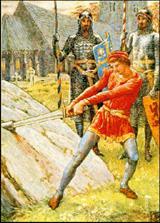

Was the Sword really in the Stone?
The idea of Arthur's drawing the Sword
from the Stone and becoming king of Britain is not to be
found in the historical texts.
And yet, one possible explanation is
this:
The Latin word for stone is saxo;
the English word for the Germanic invaders who took over the
country is Saxon. It is quite possible that the story of
Arthur had him killing a great Saxon leader and taking his
sword as a symbol of prowess and renewed vigor and victory.
It is also quite possible that in copying (which is what
they did in those days), a scribe might have forgotten to
add a letter, namely the last, to the word Saxon. Hence,
"Arthur pulled the sword from the Saxon" may have become
"Arthur pulled the sword from the stone."
Another possibility is this:
The idea of Arthur's drawing the sword
from the stone could have had its origins in the religious
beliefs of the Sarmatians, some of whom would have been left
behind when the Romans suddenly left in 410.
Also, one of the Sarmatian folktales
tells of a great hero named Batradz who owned a magical
sword. When Batradz was mortally wounded in battle, he asked
his friends to throw his sword into the water as a votive
offering. His friends refused several times but told him
they had done it; he knew, however, that they had not. When
they finally did, the water into which they threw the sword
turned red as blood. Batradz could die in peace.
This tale is remarkably similar to
Vulgate version of Griflet throwing Excalibur into the
waiting arms of the Lady of the Lake, including the two
refusals and the final acquiescence.
We turn again to Robert
de Boron for the story of the
Sword in the Stone.
Yet, Robert says the sword was in an
anvil on top of a stone. The introduction of this device
took place in Robert's Merlin. The sword symbolizes
justice, and the stone represents Christianity. By pulling
the sword from the stone, Arthur is agreeing to pursue
justice in the name of Christianity.
Later writers would omit this connection
as well as the anvil and portray the Sword in the Stone as a
test arranged by Merlin
to prove that Arthur was the true king. Mary
Stewart's telling of this is
especially memorable.
We also see the sword-stone motif in the
Vulgate
version of the Galahad
story, as the perfect knight sits on the Siege
Perilous and pulls a sword from a
stone.
See also

Was
Arthur a king or just a battle commander?
Was
Guinevere really an adulteress?
Was
Morgan Le Fay really a witch?
Was
Morgause to blame for all of Arthur's troubles?

Explorations in Arthurian History and Legends
Main
Page
Other
© 2000-2009 David White